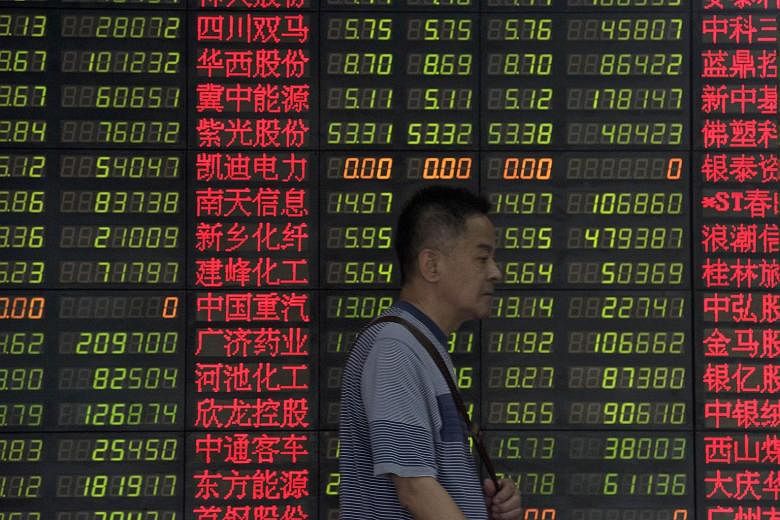SINGAPORE (BLOOMBERG) - The selloff in riskier assets gained pace on Wednesday (Sept 23) as a preliminary Chinese manufacturing gauge plunged to the lowest level since the depths of the global financial crisis, sending stocks and commodity currencies tumbling and boosting sovereign bonds.
Asian stocks headed for their biggest three-day loss since August's market rout as Chinese shares slid in Hong Kong and Shanghai. The preliminary Purchasing Managers' Index from Caixin Media and Markit Economics was at 47.0 for September, the lowest level since March 2009, when global equity markets bottomed after the collapse of Lehman Brothers. Futures on shares in the US and Japan, where markets are closed Wednesday, also tumbled.
The MSCI Asia Pacific excluding Japan Index fell 2.2 per cent by 11:17 am in Hong Kong, as the Hang Seng China Enterprises Index dropped 3.5 per cent. The Shanghai Composite Index retreated 1.9 per cent even after President Xi Jinping told a US audience that the country's stock market had reached a self-recovery phase.
The Straits Times Index was down 1.15 per cent at 2,835.55 as of 11:48 am.
South Korea's Kospi index dropped 1.3 per cent, Australia's S&P/ASX 200 Index plunged 1.7 per cent while benchmark gauges in Jakarta, Taipei and Kuala Lumpur all retreated at least 1.2 per cent. The MSCI Emerging Markets Index slid 1.6 per cent.
"It's a confirmation of fears that were existing in the market already that China is in fact doing worse than we had been led to believe and there's a lot of uncertainty about where that economy really is," said Emma Lawson, senior currency strategist at National Australia Bank Ltd. in Sydney. "Aussie has the justification to sell off."
China's manufacturing gauge, which hasn't moved above the 50 level that marks the border between expansion and contraction since March, delivered further evidence that the slowdown cited by the Federal Reserve in its decision to hold rates still has further to run. The report comes after four Fed officials have come out saying a 2015 rate increase is still on the radar, saying the US economy is strong enough to withstand transitory volatility from abroad.
The so-called flash PMI number missed the median estimate of 47.5 in a Bloomberg survey and was below the final reading of 47.3 for last month. Premier Li Keqiang's expansion target of about 7 per cent for this year is being challenged by a slowdown in manufacturing and property investment even after five interest-rate cuts since November.
Futures on the Standard & Poor's 500 Index dropped 0.8 per cent, while Singapore-traded contracts on Japan's Nikkei 225 Stock Average were down 3.1 per cent from Friday's close. Markets in Tokyo resume Thursday following a three-day break.
"These numbers would add a more cautionary tone to the market's perception of the risks around the Chinese growth profile and further reinforces the risk off attitude in the market," Chris Green, an Auckland-based strategist at First NZ Capital Ltd., said by phone. "The clock is ticking for the Fed to lift rates but the weakening data we're seeing in China justifies the cautionary approach from the Fed."
The offshore yuan dropped 0.29 per cent, the most since Sept 10, to 6.4255 a dollar in Hong Kong, according to data compiled by Bloomberg. The spot rate in Shanghai weakened 0.13 per cent to 6.3834, China Foreign Exchange Trade System prices show.
China won't devalue the yuan to boost exports, President Xi said in a speech in Seattle. The nation is opposed to currency wars and there is no basis for continuous depreciation of the yuan, he added.
The yen strengthened 0.3 per cent to 119.79, benefiting from its status as a haven asset as investors retreated from commodity and emerging-market currencies. The euro was 0.2 per cent stronger at US$1.1137 after sliding 2.8 per cent in the previous three sessions. The Australian dollar slumped 0.8 per cent to 70.32 US cents.
New Zealand's currency weakened 0.5 per cent with South Africa's rand. Malaysia's ringgit plunged 1.2 per cent to 4.3468 per US dollar, heading toward its weakest finish since January 1998. Indonesia's rupiah also plumbed fresh 17-year lows, sliding 0.9 per cent to 14,628 to the greenback.
The Bloomberg Commodity Index slipped 0.1 per cent and is heading for its lowest close since Aug 26, when it tumbled to levels last seen in August 1999.
WTI for November delivery fell 0.3 per cent to US$46.21 a barrel on the New York Mercantile Exchange. The October contract expired Tuesday after swinging by more than 4 per cent on three occasions in its last five trading days. Prices have decreased 13 per cent this year.

